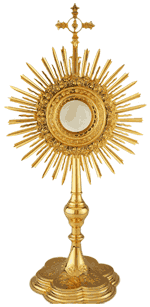One of my favorite saints, and one of the patrons of the City of Rome is the Deacon-Martyr, St. Lawrence. There are actually more churches built in Rome to honor St. Lawrence in the Holy City than any other saint, including St. Peter, himself. His story of courage and his great love for the poor reveal the reasons behind these devotions. During the persecutions of the Emperor Valerian in 258 A.D., numerous priests and deacons were put to death and wealthier Christians had their wealth confiscated and were forced into exile. Pope Sixtus II was one of the first victims of this persecution, being beheaded on August 6. According to the writings of St. Ambrose, as Pope Sixtus was being lead to his death, Lawrence met him and asked: “Where are you going, my dear father, without your son? … [Read more...]
Marriage and Sexuality
The desire to love and be loved is the deepest need of our being. We long to be known, accepted, and cherished by another. Yet, the ability to fully give or receive this love is unattainable on our own. As Catholics we believe Jesus Christ has entered our broken world to conquer sin and restore us to new life. Throughout every age he continues to invite all women and men to follow him through his Church, to whom he has entrusted his teaching authority, so that all can know and follow him. Only God can give us the unconditional love and acceptance that we desire. Yet, he has created marriage, a holy union, to mirror this supreme love on earth. At the heart of their married love is the total gift of self that husband and wife freely offer to each other. Because of their sexual … [Read more...]
The Symbolism of the Pelican
During the years I lived in Rome, I spent a lot of time trying to decipher and understand early Christian symbolism. It was a hobby of mine as I visited churches and saw so much iconography. Recently, someone visited St. Stephen Church in New Orleans and asked me about an image that they saw high over the sanctuary of a pelican feeding its young. They wondered why someone would have painted the “state bird” in church! The question gave me a good occasion to reflect upon church symbolism. The image of the mother pelican feeding her baby pelicans is rooted in several ancient Roman legends that precede Christianity. One version is that in time of famine, the mother pelican wounded herself, striking her breast with her beak to feed her young with her blood. Another version was that the … [Read more...]
Good Church Etiquette
An instructive reminder Remember to keep your Eucharistic fast by abstaining from food and beverages (water excluded) for an hour before Mass. Always dress modestly and appropriately. Arrive early to allow for personal prayer and/or read the readings of the day. Turn off all mobile devices while still in the vestibule. This is your time with God and His people. Use the restroom before or after Mass. Men remove hats or caps before the Lord. Deposit all water bottles in the waste receptacles. Make the sign of the cross with Holy Water upon entering. Genuflect with great reverence towards the Blessed Sacrament in the tabernacle before entering your pew. If unable to genuflect, a profound bow is respectful. Refrain from chit-chat which distracts others who are … [Read more...]
Feast of St. Mary Magdalene July 22
Mary was called “Magdalen” because she was either from Magdala near Tiberias (on the west shore of Galilee) or possibly from a Talmudic expression meaning “curly women's hair,” which means an adulteress. In the New Testament Mary is mentioned among the women who accompanied Christ and ministered to Him (Luke 8:2-3), where it is also said that seven devils had been cast out of her (Mark 16:9). She is next named as standing at the foot of the cross (Mark 15:40; Matthew 27:56; John 19:25; Luke 23:49). She saw Christ laid in the tomb, and she was the first recorded witness of the Resurrection. The Greek Fathers, as a whole, distinguish the “sinner” of Luke 7:36-50; Mary, the sister of Martha and Lazarus, and Mary Magdalen. On the other hand most of the Latin Fathers hold that these three … [Read more...]
Feast of Our Lady of Mount Carmel – July 16
Our Lady of Mount Carmel is the title given to the Blessed Virgin Mary in her role as patroness of the Carmelite Order. The first Carmelites were Christian hermits living on Mount Carmel in the Holy Land during the late 12th and early to mid-13th century. They built in the midst of their hermitages a chapel which they dedicated to the Blessed Virgin, whom they conceived of in chivalric terms as the "Lady of the place." Our Lady of Mount Carmel was adopted in the 19th century as the patron saint of Chile, in South America. Since the 15th century, popular devotion to Our Lady of Mount Carmel has centered on the Scapular of Our Lady of Mount Carmel, also known as the Brown Scapular, a sacramental associated with promises of Mary's special aid for the salvation of the devoted wearer. … [Read more...]
Signing with Courage
Signing with Courage - Charles Carroll of Carrollton The legal separation of the American colonies from Great Britain occurred on July 2, 1776, when the Second Continental Congress voted to approve a resolution of independence that had been proposed in June by Richard Henry Lee of Virginia. After voting for independence, Congress turned its attention to the Declaration of Independence, a statement explaining this decision, which had been prepared by a committee with Thomas Jefferson as its principal author. Congress debated and revised the Declaration, finally approving it on July 4. A day earlier, John Adams had written to his wife Abigail: The second day of July, 1776, will be the most memorable epoch in the history of America. I am apt to believe that it will be celebrated by … [Read more...]
Divorced People Are Not “Outside” the Church
[What follows is a clarification from the Holy Father. Pope-Emeritus Benedict XVI, that you might consider handing along to any of your Catholic friends who are divorced and remarried] We sometimes hear from our friends who are divorced and remarried: “I’m excommunicated.” That’s not true at all. During the World Meeting of Families held in 2012 in Milan, a Brazilian family raised the issue of divorced couples who have remarried and cannot avail themselves of the Sacraments. Pope Benedict XVI affirmed that “this is one of the great causes of suffering for the Church today, and we do not have simple solutions. Naturally, one very important factor is prevention. This means ensuring that, from the beginning, the act of falling in love is transformed in a more profound and mature … [Read more...]
Religious Liberty is the Foundation of the United States of America
Below is an example of how the Founding Fathers understood the issue of “religious liberty” in our country from the beginning. It is a letter written by then-president Thomas Jefferson in response to a letter from the sisters of the Ursuline Convent, New Orleans, Louisiana, after the French colony of Louisiana was transferred to the jurisdiction of the United States of America via the Louisiana Purchase. The sisters were concerned about how the United States would regard their religious freedom. * * * * Washington May 15, 1804 To the Soeur Terese de St. Xavier Farjon, Superior, and the Nuns of the Order of St. Ursula at New Orleans. I have received, holy sisters, the letter you have written me wherein you express anxiety for the property vested in your … [Read more...]
How Should I Dress for Mass?
by Archbishop Gregory M. Aymond Summer is here, which in New Orleans usually means dressing down even more casually than we do at other times of year. I know the issue of church attire is a sensitive one – especially in an area where it's hot nine months out of the year. What's your perspective on how people should dress for Mass? I have a variety of feelings about this. There’s a part of me that remains grateful to God that a person is in church, regardless of how he or she is dressed. I certainly realize there are individual circumstances where a person may have other responsibilities and is not able to dress in what we might consider an appropriate manner, so I want to be sensitive to that. At the same time, the church is a sacred place – truly holy ground. It is a consecrated … [Read more...]




